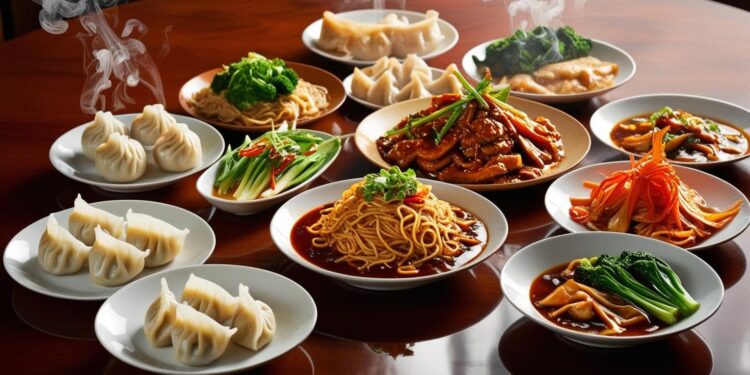Introduction: A Chinese Food Philosophy That Nourishes the Body and Soul
Imagine a cuisine where every dish is crafted not only for taste but also for harmony within your body. In Chinese culture, food is seen as medicine, and every meal carefully balances opposite forces like Yin and Yang. For thousands of years, Chinese food wisdom has gone beyond satisfying hunger; it aims to maintain balance, vitality, and inner peace. This article will help you find out everything about how Chinese cuisine beautifully intertwines health, culture, and flavor, offering lessons we can all apply to our modern diets.
Understanding Yin and Yang Chinese Food
The core of Chinese cooking is based on the ancient idea of Yin and Yang — two forces that need to stay in balance for the body to stay healthy. Yin cools and calms, while Yang warms and energizes.
In the context of food:
- Yin foods include cucumber, watermelon, crab, and tofu — foods that cool the body.
- Yang foods like lamb, ginger, chilies, and garlic, warm and boost the body’s energy.
A balanced Chinese meal carefully combines Yin and Yang elements to create a holistic experience that nurtures the body and prevents illness. When you savor a classic hot and sour soup, or a plate of stir-fried vegetables with ginger, you are tasting centuries of wisdom at work.
The Role : Authentic Chinese Food
Beyond Yin and Yang, Chinese cuisine also reflects the Five Elements theory: wood, fire, earth, metal, and water. Each element corresponds to certain flavors:
- Wood: Sour
- Fire: Bitter
- Earth: Sweet
- Metal: Spicy
- Water: Salty
Chefs aim to balance these flavors in a single meal, believing that aligning the elements promotes well-being. For example, a dish might pair spicy Sichuan peppers (metal) with sweet honey (earth) to support multiple body systems at once.
Tip: When cooking at home, think about balancing not just textures and colors but also different taste profiles to create meals that feel satisfying and complete.
Everyday Examples of Yin-Yang Balance in Traditional Dishes
Many beloved Chinese dishes are natural examples of Yin-Yang balance:
- Hot Pot: Features spicy broths (Yang) alongside cooling vegetables and tofu (Yin).
- Congee (Rice Porridge): A Yin dish often paired with Yang toppings like pickled vegetables or spicy meats.
- Peking Duck: The crispy, fatty duck (Yang) is eaten with cooling cucumber and sweet bean sauce (Yin).
Each meal is an opportunity to restore balance depending on your needs — if you’ve been feeling sluggish (Yin), you might crave warming, Yang-rich foods. If you’re overheated or stressed (Yang overload), cooling Yin dishes offer relief.
How to Apply Yin-Yang Wisdom to Your Modern Meals
You don’t have to master Chinese cooking to bring Yin-Yang balance into your meals. Here’s how you can start:
- Listen to your body: Are you feeling cold and tired? Try spicy, warming foods. Feeling overheated? Choose light, watery dishes.
- Balance your plate: Combine a variety of textures, temperatures, and flavors in one meal.
- Season with intention: Use herbs like mint (Yin) or ginger (Yang) to adjust your food’s energy.
- Stay seasonal: In summer, focus on Yin-rich foods like melons. In winter, favor Yang foods like lamb stew.
Balancing Yin and Yang isn’t just a diet — it’s a lifestyle. By aligning your food with your body’s changing needs, you cultivate energy, vitality, and a deeper connection to nature.
Why Chinese Cuisine Offers More Than Just Flavor
The centuries-old practice of harmonizing Yin and Yang is what gives Chinese cuisine its profound health benefits. It’s not just about delicious meals — it’s about preventive care, emotional well-being, and honoring the body’s natural rhythms.
Modern studies even support these practices, finding that traditional Chinese diets can reduce inflammation, support digestion, and promote longevity. In a world where fast food dominates, the ancient Chinese approach reminds us to slow down and respect the deep connection between what we eat and how we feel.
Conclusion: Chinese Food
Chinese cuisine isn’t just about taste — it’s a rich, thoughtful expression of balance, energy, and healing. By understanding and applying the principles of Yin and Yang to your everyday meals, you can transform not only your diet but your overall well-being.
Ready to bring centuries of culinary wisdom into your kitchen?
Start experimenting with Yin and Yang today, and feel the difference in every bite.
Share your experience or favorite balanced dishes with us in the comments — we’d love to hear from you!




































